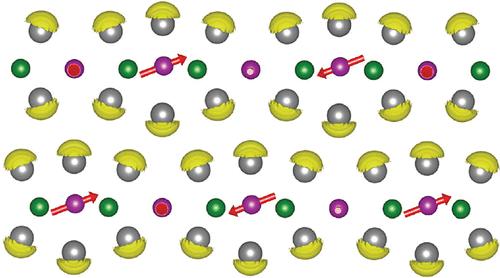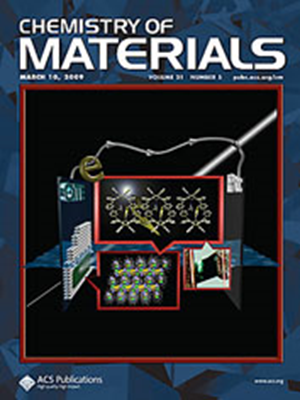MnRhBi3: A Cleavable Antiferromagnetic Metal
IF 7
2区 材料科学
Q2 CHEMISTRY, PHYSICAL
引用次数: 0
Abstract
Cleavable metallic antiferromagnets may be of use for low-dissipation spintronic devices; however, few are currently known. Here we present orthorhombic MnRhBi3 as one such compound and present a thorough study of its physical properties. Exfoliation is demonstrated experimentally, and the cleavage energy and electronic structure are examined by density functional theory calculations. It is concluded that MnRhBi3 is a van der Waals-layered material that cleaves easily between neighboring Bi layers and that the Bi atoms have lone pairs extending into the van der Waals gaps. A series of four phase transitions are observed below room temperature, and neutron diffraction shows that at least two of the transitions involve the formation of antiferromagnetic order. Anomalous thermal expansion points to a crystallographic phase transition and/or strong magnetoelastic coupling. This work reveals a complex phase evolution in MnRhBi3 and establishes this cleavable antiferromagnetic metal as an interesting material for studying the interplay of structure, magnetism, and transport in the bulk and ultrathin limits, as well as the role of lone pair electrons in interface chemistry and proximity effects in van der Waals heterostructures.

MnRhBi3:一种可裂解的反铁磁性金属
可裂解金属反铁磁体可用于低耗散自旋电子器件,但目前已知的反铁磁体很少。在此,我们介绍了正交锰硼(MnRhBi3)这种化合物,并对其物理性质进行了深入研究。实验证明了其剥离性,并通过密度泛函理论计算研究了其裂解能和电子结构。结论是 MnRhBi3 是一种范德华层材料,在相邻的 Bi 层之间很容易裂开,而且 Bi 原子的孤对电子延伸到范德华间隙中。在室温以下观察到一系列四个相变,中子衍射显示其中至少有两个相变涉及反铁磁秩序的形成。反常的热膨胀表明存在晶体学相变和/或强磁弹性耦合。这项研究揭示了 MnRhBi3 复杂的相变过程,并将这种可裂解的反铁磁性金属确定为一种有趣的材料,用于研究结构、磁性和传输在块体和超薄极限中的相互作用,以及孤对电子在范德华异质结构中的界面化学和邻近效应中的作用。
本文章由计算机程序翻译,如有差异,请以英文原文为准。
求助全文
约1分钟内获得全文
求助全文
来源期刊

Chemistry of Materials
工程技术-材料科学:综合
CiteScore
14.10
自引率
5.80%
发文量
929
审稿时长
1.5 months
期刊介绍:
The journal Chemistry of Materials focuses on publishing original research at the intersection of materials science and chemistry. The studies published in the journal involve chemistry as a prominent component and explore topics such as the design, synthesis, characterization, processing, understanding, and application of functional or potentially functional materials. The journal covers various areas of interest, including inorganic and organic solid-state chemistry, nanomaterials, biomaterials, thin films and polymers, and composite/hybrid materials. The journal particularly seeks papers that highlight the creation or development of innovative materials with novel optical, electrical, magnetic, catalytic, or mechanical properties. It is essential that manuscripts on these topics have a primary focus on the chemistry of materials and represent a significant advancement compared to prior research. Before external reviews are sought, submitted manuscripts undergo a review process by a minimum of two editors to ensure their appropriateness for the journal and the presence of sufficient evidence of a significant advance that will be of broad interest to the materials chemistry community.
 求助内容:
求助内容: 应助结果提醒方式:
应助结果提醒方式:


